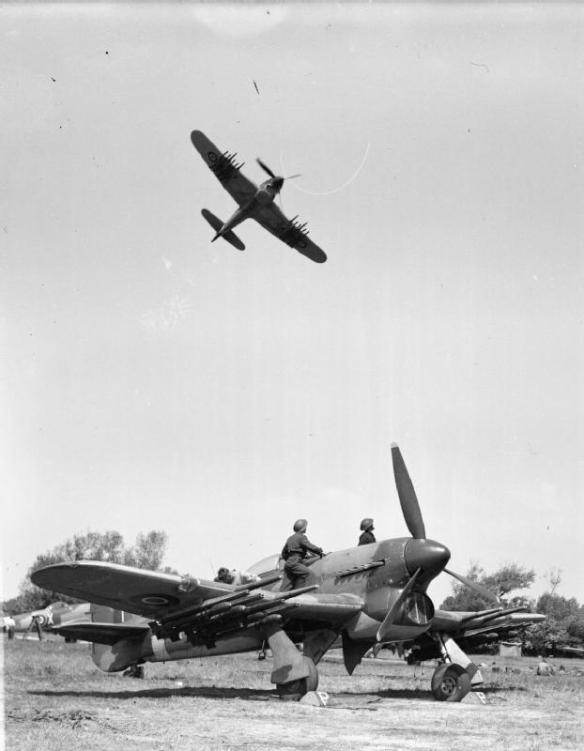
Virtually immediately the tactical fighter-bombers of the IX TAC and 2 TAF made their presence felt on the land battle. For the first four days of the invasion, they flew from their bases in southern England, but the first rough airstrips were available for use on the Continent on June 10. Eventually Allied fighter-bomber strips numbered thirty-one in the British zone and fifty in the American. Two problems quickly manifested themselves in these early operations at the front. The peculiar thick dust of Normandy played havoc with the inline engines of the Spitfire and Typhoon, until mechanics fitted special air filters to the aircraft and engineers watered down the runway surface. Second, these forward strips were perilously close to enemy positions and came under frequent shelling. In one case, Typhoons operating from a forward strip attacked German tanks and fortifications a mere 1,000 yards away from the runway, an operation calling to mind more the experience of the Marines and Army at Guadalcanal or at Peleliu than the European campaign.
The ordeal of the German Panzer-Lehr Division offers a good example of the fate awaiting German ground forces in Normandy. Ordered north to confront the invasion, the armored division got underway in the late afternoon of June 6, and came under its first air attack at 0530 on the 7th near Falaise. Blasted bridges and bombed road intersections hindered movement, particularly of support vehicles. So intense were the attacks along the Vire-Beny Bocage road that division members referred to it as a Jabo Rennstrecke-a fighter-bomber race-course. Air attack destroyed more than 200 vehicles on June 7 alone. Despite the rainy weather, which had threatened the Allies’ landing on the beachhead, fighter-bombers continued to strike at the Panzer-Lehr Division, to the dismay of German soldiers who had hoped the worsening weather would offer some respite. This was just the beginning of an ordeal that would last throughout the French campaign; Panzer-Lehr was in for some more rough times in the near future.
This division was by no means alone in its trials. The 2d SS Panzer Division Das Reich made its way from Toulouse to Normandy, encountering serious delays en route and, in typical SS fashion, responding by murdering and otherwise brutalizing the civilian population of France. Once the division crossed the Loire, it had a taste of real war; as Max Hastings relates,
… questing fighter bombers fell on them ceaselessly. The convoys of the Das Reich were compelled to abandon daylight movement after Saumur and Tours and crawl northwards through the blackout …. [During a change of command] an Allied fighter bomber section smashed into the column, firing rockets and cannon. Within minutes … sixteen trucks and half-tracks were in flames …. Again and again, as they inched forward through the closely set Norman countryside, the tankmen were compelled to leap from their vehicles and seek cover beneath the hulls as fighter bombers attacked. Their only respite came at night.
While darkness offered some protection to the besieged Germans, it did not grant total immunity. The 2 TAF used twin-engine De Havilland Mosquitos as night battlefield interdiction aircraft, sometimes having the “Mossies” bomb and strafe under the light of flares dropped from North American Mitchell medium bombers. Later in the European campaign, when the German night air attack menace had largely disappeared, the AAF used Northrop P-61 Black Widow night fighters in a similar role. Overall, however, their inability to successfully prosecute night attacks to the same degree as daytime attacks frustrated air and ground commanders alike. Bradley’s air effects committee noted that there was “never enough” night activity to meet the Army’s needs.
Intelligence information from Ultra set up a particularly effective air strike on June 10. German message traffic had given away the location of the headquarters of Panzergruppe West on June 9, and the next evening a mixed force of forty rocket-armed Typhoons and sixty-one Mitchells from 2 TAF struck at the headquarters, located in the Chateau of La Caine, killing the unit’s chief of staff and many of its personnel and destroying fully 75 percent of its communications equipment as well as numerous vehicles. At a most critical point in the Normandy battle, then, the Panzer group, which served as a vital nexus between operating armored forces, was knocked out of the command, control, and communications loop; indeed, it had to return to Paris to be reconstituted before resuming its duties a month later.